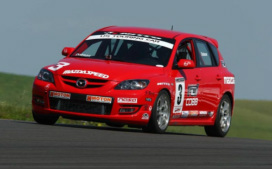Benefits of FWD
There are many reasons listed for why the OEM companies are using FWD. They include costs, size, assembly, interchangeability, etc., which may be considered but certainly aren't the main cause. Looking at just the pieces involved in the drive train will lead to the answer. The FWD cars don't have a 5 foot long driveshaft and have a 12-18 inch shorter transmission (i.e., output shaft). Both pieces rotate with the engine. Drag racers learned years ago that lighter rotating pieces (in the engine or the transmission) make the car go faster at the track. It isn't found on the dyno but can be easily proven in the car at the track. Having no driveshaft and only half the transmission shaft saves 15-20 pounds of rotating weight. Drag racers spend thousands of dollars to get 5 pounds out of the rotating mass of the engine.
A related consideration that may be more important in handling is unsprung weight. The 5 ft. driveshaft was unsprung weight. All FWD cars use an independent suspension while 99 percent of the RWD cars (front engine) use a solid axle. Weigh the solid axle and realize that it's all unsprung weight. We think that every handling "expert" knows that less unsprung weight help handling!
FWD Handling Characteristics
A vehicle's handling characteristics are not always the same. A FWD car at extremely low speed will tend to understeer. Strangely enough, a front-engine RWD car understeers at low speed also. Both are caused by the front weight bias. At higher speeds, typical of minimum speeds at a road race track, the springs and sway bars come into play and the car reverts to its designed characteristics. In production cars, the design choice is slightly understeering.
It is obvious that the FWD cars use the front tires for acceleration, braking and cornering. This demands a lot of the tire. However, in two cars, one FWD, one RWD, both in the same class, the FWD car is somewhat faster in lap times but it uses up the tires faster.
In summary we think that the examples listed above show what's going on in racing and why the FWD cars are so popular. The at-the-track evidence shows that the FWD cars do go faster and handle better even though they work the tires very hard. They may not make the greatest drag cars but we're talking handling and road racing and that seems to be where the FWD cars do best. They also seem to handle better in traffic which makes close racing easier. The at-the-track evidence speaks for itself.
Selected text from Mopar 2.2/2.5 FWD, 1995
There are many reasons listed for why the OEM companies are using FWD. They include costs, size, assembly, interchangeability, etc., which may be considered but certainly aren't the main cause. Looking at just the pieces involved in the drive train will lead to the answer. The FWD cars don't have a 5 foot long driveshaft and have a 12-18 inch shorter transmission (i.e., output shaft). Both pieces rotate with the engine. Drag racers learned years ago that lighter rotating pieces (in the engine or the transmission) make the car go faster at the track. It isn't found on the dyno but can be easily proven in the car at the track. Having no driveshaft and only half the transmission shaft saves 15-20 pounds of rotating weight. Drag racers spend thousands of dollars to get 5 pounds out of the rotating mass of the engine.
A related consideration that may be more important in handling is unsprung weight. The 5 ft. driveshaft was unsprung weight. All FWD cars use an independent suspension while 99 percent of the RWD cars (front engine) use a solid axle. Weigh the solid axle and realize that it's all unsprung weight. We think that every handling "expert" knows that less unsprung weight help handling!
FWD Handling Characteristics
A vehicle's handling characteristics are not always the same. A FWD car at extremely low speed will tend to understeer. Strangely enough, a front-engine RWD car understeers at low speed also. Both are caused by the front weight bias. At higher speeds, typical of minimum speeds at a road race track, the springs and sway bars come into play and the car reverts to its designed characteristics. In production cars, the design choice is slightly understeering.
It is obvious that the FWD cars use the front tires for acceleration, braking and cornering. This demands a lot of the tire. However, in two cars, one FWD, one RWD, both in the same class, the FWD car is somewhat faster in lap times but it uses up the tires faster.
In summary we think that the examples listed above show what's going on in racing and why the FWD cars are so popular. The at-the-track evidence shows that the FWD cars do go faster and handle better even though they work the tires very hard. They may not make the greatest drag cars but we're talking handling and road racing and that seems to be where the FWD cars do best. They also seem to handle better in traffic which makes close racing easier. The at-the-track evidence speaks for itself.
Selected text from Mopar 2.2/2.5 FWD, 1995

 RSS Feed
RSS Feed